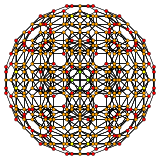截角正六百胞体
外观
| 截角正六百胞体 | |
|---|---|
 | |
| 类型 | 均匀多胞体 |
| 识别 | |
| 名称 | 截角正六百胞体 |
| 参考索引 | 41 |
| 数学表示法 | |
| 考克斯特符号 | |
| 施莱夫利符号 | t0,1{3,3,5} |
| 性质 | |
| 胞 | 720: 120 600 |
| 面 | 2400{3}+1200{6} |
| 边 | 4320 |
| 顶点 | 1440 |
| 组成与布局 | |
| 顶点图 |  五角柱 |
| 对称性 | |
| 考克斯特群 | H4, [3,3,5], order 14400 |
| 特性 | |
| convex | |
截角正六百胞体是均匀多胞体之一。它是通过截断正六百胞体的每一个角得到的。它有720个胞:120个正二十面体和600个截角四面体。它的顶点图是一个五角柱,一个顶点周围有一个正二十面体和五个截角四面体。
结构
[编辑]截角正六百胞体由600个截角四面体和120个正二十面体。截角四面体胞通过六边形面互相结合,并且通过三角形面来结合正二十面体胞。每个正二十面体胞结合20个 截角四面体胞。
投影
[编辑] 对着一个正二十面体胞 |
 对着一个截角四面体胞 |
 中心部分 和一些红色的正二十面体 |
 展开图 |
| H4 | - | F4 |
|---|---|---|
 [30] |
 [20] |
 [12] |
| H3 | A2 / B3 / D4 | A3 / B2 |
 [10] |
 [6] |
 [4] |
| 三维正交投影 | |
|---|---|

|
截角正六百胞体的三维正交投影,对着一个正二十面体胞。最中间的正二十面体是红色的,其余的正二十面体是黄色的,截角四面体是透明的绿色的。 |
参考文献
[编辑]- Kaleidoscopes: Selected Writings of H.S.M. Coxeter (页面存档备份,存于互联网档案馆), editied by F. Arthur Sherk, Peter McMullen, Anthony C. Thompson, Asia Ivic Weiss, Wiley-Interscience Publication, 1995, ISBN 978-0-471-01003-6
- (Paper 22) H.S.M. Coxeter, Regular and Semi-Regular Polytopes I, [Math. Zeit. 46 (1940) 380-407, MR 2,10]
- (Paper 23) H.S.M. Coxeter, Regular and Semi-Regular Polytopes II, [Math. Zeit. 188 (1985) 559-591]
- (Paper 24) H.S.M. Coxeter, Regular and Semi-Regular Polytopes III, [Math. Zeit. 200 (1988) 3-45]
- J.H. Conway and M.J.T. Guy: Four-Dimensional Archimedean Polytopes, Proceedings of the Colloquium on Convexity at Copenhagen, page 38 und 39, 1965
- N.W. Johnson: The Theory of Uniform Polytopes and Honeycombs, Ph.D. Dissertation, University of Toronto, 1966
- Four-dimensional Archimedean Polytopes (页面存档备份,存于互联网档案馆) (German), Marco Möller, 2004 PhD dissertation [1] (页面存档备份,存于互联网档案馆) m58 (页面存档备份,存于互联网档案馆) m59 (页面存档备份,存于互联网档案馆) m53 (页面存档备份,存于互联网档案馆)
- Convex uniform polychora based on the hecatonicosachoron (120-cell) and hexacosichoron (600-cell) - Model 36, 39, 41, George Olshevsky.
- Klitzing, Richard. 4D uniform polytopes (polychora). bendwavy.org. o3o3x5x - thi, o3x3x5o - xhi, x3x3o5o - tex
- Four-Dimensional Polytope Projection Barn Raisings (页面存档备份,存于互联网档案馆) (A Zometool construction of the truncated 120-cell), George W. Hart
